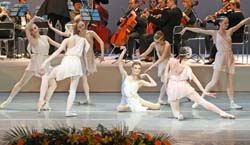Lifar, spring, Kyiv
The place of dancing cannot be changed
For three days the National Opera hosted the “Serge Lifar de la danse” 9th Ballet Festival commemorating this outstanding Kyiv-born dancer and choreographer destined to display his overwhelming talent not in the native land but in Western Europe.
Lifar’s name is associated with the Paris Opera Ballet to which he devoted 30 years of life and work and where he staged some 200 productions.
In 1994, a competition and festival in his honor and after his name were instituted in Kyiv, and the National Opera of Ukraine staged three ballets in his interpretation, jointly with French colleagues who had danced in his productions: Romeo and Juliet to Tchaikovsky’s music, Lalo’s Suite in White, and Pulenko’s Morning Serenade (Aubade). These three productions made up the program of the first day of this year’s festival. Their neoclassical style originated by Lifar, who sought new forms within its rather extensive boundaries, is especially close to the National Opera’s top-notch ballet troupe.
The first part of the program consisted of the Morning Serenade that was first staged by the Opera de Monte Carlo in 1946. Prima ballerina Tetiana Holiakova and Andrii Hura, winner of the first Lifar competition, starred in the mythological scene where the light-minded Acteon tries to seduce Diana, the implacable patroness of hunting.
The second part included Romeo and Juliet, starring Natalia Lazebnykova, whose tender romanticism and penetrating impersonation are so attractive to the audience, and Andrii Hura (this time the premier danseur turned into a young man tragically in love), and Lifar’s sparkling and bewitching version of the Suite in White. Too bad this ballet is staged only during competitions or festivals. Judging by the audience’s warm response, it could be a worthy addition to the company’s repertoire.
The second day of the festival was totally dominated by the boundless and innovative fantasy of Ondrej Soth, the artistic director of the Slovak Presidential Ballet Theater, whose troupe presented Michael Kocab’s Odysseus.
What made this production so unusual was a combination of ballet, classical and rock music, songs, even video tapes. For Kyiv’s ballet buffs the Slovak troupe was also interesting because they could watch and assess dancers who only recently were soloists with the National Opera. Thus, Olesia Makarenko danced as Penelope. She and Yehorov are winners of a Lifar competition. Liudmyla Vasylieva danced as Circe. All were their usual top-notch selves on stage.
Among the subsequent concert numbers as part of the festival program the audience especially warmly received three ones with Soth’s dancers, from his project Atelier (European Choreography Soiree) that premiered on March 14 in Kosice. The number “Styx” to Kancheli’s music (staged by ballet dancer Maksym Skliar) was dramatic and very modern in its philosophical perception of life and death. Natalia Khorechna’s “Soldiers’ Lullaby” used the Ukrainian song Oi polechko, pole and the rock composition “Soldier.” This number is originally meant for twin performers and in their absence is done by two actors who bear close physical resemblance. The number “Hostages of Feelings” (choreographed by Irji Bubenicek) was permeated with reflections on solitude and separation.
After the concert that lasted for an hour and a half, not all remained in the audience to watch Scheherazade starring the excellent dancers Olena Filipieva and Oleksandr Shapoval. Well, the organizing committee should have done a better job.






